#Bike Helmets
Explore tagged Tumblr posts
Text
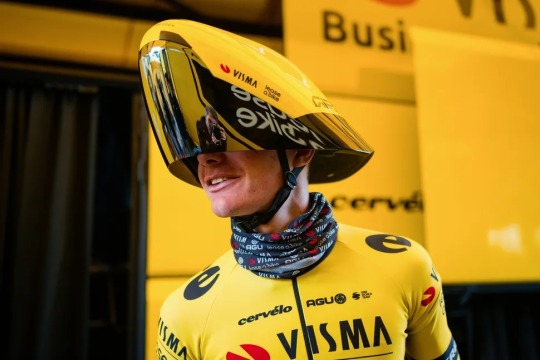
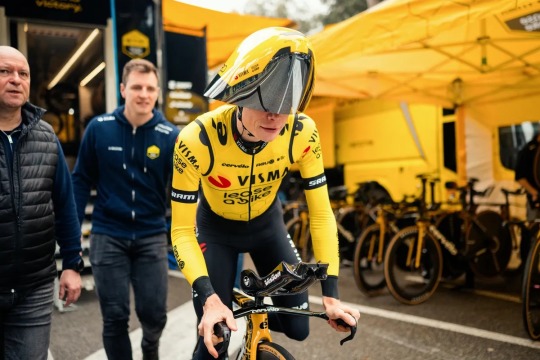
Time trial helmets are getting out of control.
6 notes
·
View notes
Text
okay i guess i have a little bit to add to bicycle helmet discourse, but it's kind of tangential to the other conversations so i'm really just using this as an excuse to share information that people might not know about helmets lol
wear a helmet unless you have a good reason not to: helmets do reduce head injuries and fatalities (and this is true in europe too - here's a study commissioned by the norwegian public roads administration on the impacts of helmets in cyclist accidents). so unless there are mitigating circumstances like health or cost that make it impossible for you to wear a helmet, you should do absolutely do it!
make sure your helmet is in good shape: if you are a regular biker, you may want to consider replacing your helmet every three to five years (but you can keep it for longer if you're a more sporadic biker), and you should definitely replace a helmet that has been through some kind of accident, even if it doesn't seem damaged
laws requiring helmets are unjust (in the u.s., but maybe elsewhere too): helmets are great, but using helmets as the fulcrum of policy interventions for bikers can actually perpetuate racial and economic injustices. studies in many u.s. cities have found that laws requiring bikers to wear helmets result in police disproportionately giving and enforcing citations/fines on bikers who are black, native, and/or homeless, as well as using such stops as pretexts to try and charge them with other things. my city, seattle, was the largest city in the country to enforce a helmet law until our county overturned all helmet laws last year to prevent this kind of police harassment - with support from local bike organizations. so helmets are good, but requiring them by law has bad side effects. (i tried to find out whether there's data from other countries, but nothing turned up, so maybe this hasn't been studied as widely outside the u.s.)
u.s.-ians, don't let helmets cover up the bigger problems: as with most issues of health and injustice, the real safety problems for bikers in the u.s. lies far deeper: in our infrastructure and our reliance on cars. we can be annoyed at europeans who say they don't need helmets, but they are correct that helmets are treating the symptom, not the cause. don't let your support of helmet-wearing keep you from also advocating for more protected bike lanes, better public transit, lower speed limits for vehicles, and other things that will better protect bikers (and pedestrians, for that matter)
14 notes
·
View notes
Text
Top-Quality Bike Helmets at Browns Hobby and Game
The trusted Canadian destination for outdoor and recreational gear, Browns Hobby and Game carries a wide selection of premium bike helmets. Our selection of helmets ensures safety, comfort, and style, whether you're a casual rider or a cycling enthusiast. Shop online or visit our Winnipeg store to find the perfect fit and design for your next ride. With helmets designed for all ages and skills levels, you can gear up with confidence. The outdoor experience at Browns Hobby and Game is enhanced by quality products and exceptional customer service.
For more information, visit here:
Email: [email protected]
Address: PH20-19 Singer Court, North York Ontario, M2K 0B2, Canada
Phone No.: 647668-0460
0 notes
Text

Full face dual visor flip up bike helmets
0 notes
Text
Bike Helmet Buying Guide Ensuring Safety and Comfort
Discover our bike helmet buying guide to ensure safety and comfort. Get insights on fit, safety certifications, and features to look for in a high-quality helmet.
0 notes
Text
7 Reasons Why Motorcycle Youth Helmets are Essential
Drawing from my extensive experience as a powersport bike rider, I've always emphasized the importance of safety, especially when it comes to younger riders. A crucial element of this safety is the use of motorcycle youth helmets. In this blog, I’ll discuss seven compelling reasons why motorcycle youth helmets are essential, offering insights and advice for ensuring the safety of our future generation of riders.
Introduction
Introducing young riders to the world of motorcycling is an exhilarating journey. However, it comes with the responsibility of instilling a safety-first mindset from the outset. At the forefront of this is the use of motorcycle youth helmets. These helmets are not just a safety accessory but a necessary tool in safeguarding young riders. Let's explore the seven key reasons why motorcycle youth helmets are indispensable.
1. Head Protection in Accidents
Crucial Impact Absorption:
Vulnerability of Young Riders: Young riders are more vulnerable to injuries. In an accident, a helmet can be the difference between a minor injury and a life-altering one.
Design and Technology: Discuss how youth helmets are designed with materials and technology focused on absorbing impact and protecting the brain.
2. Legal Requirements and Compliance
Adhering to Safety Standards:
Mandatory Helmet Laws: Many regions have strict laws requiring helmets for all riders, including youth. Non-compliance can lead to legal consequences.
Helmet Certifications: Explain the importance of choosing helmets that meet recognized safety standards like DOT, ECE, or SNELL.
3. Developing Safety Habits
Instilling a Culture of Safety:
Early Education: Wearing a helmet from a young age ingrains safety habits that can last a lifetime.
Role Modeling: As experienced riders, wearing helmets ourselves sets a positive example for young riders.
4. Protection from Environmental Factors
Shielding Against the Elements:
Weather and Debris: Helmets protect against sun, wind, rain, and road debris, which can be distracting or harmful during a ride.
Comfort Features: Highlight features like visors, ventilation systems, and padding that enhance comfort in various weather conditions.
5. Enhanced Visibility
Being Seen by Others:
High-Visibility Designs: Many youth helmets come in bright colors or with reflective materials, making young riders more visible to other road users.
Importance of Being Noticed: Discuss how enhanced visibility can significantly reduce the risk of accidents.
6. Technology Integration
Modern Helmets for the Young Rider:
Communication Systems: Some youth helmets are equipped or compatible with communication systems, allowing for safe and easy communication on the go.
Smart Features: Touch on helmets with integrated technology like GPS tracking or crash detection, offering added safety features.
7. Comfort and Fit
Encouraging Consistent Use:
Proper Sizing: Explain the importance of properly fitting helmets for comfort and effectiveness. A helmet that fits well is more likely to be worn consistently.
Adjustability for Growth: Discuss helmets with adjustable interior padding or sizing systems that can accommodate a growing child.
Choosing the Right Helmet
Factors to Consider:
Safety and Style: While safety should be the primary concern, allowing young riders to choose a helmet style they like can encourage them to wear it willingly.
Budget Considerations: Offer advice on balancing budget with quality, emphasizing that safety should not be compromised for cost.
Maintaining the Helmet
Ensuring Long-Term Safety:
Care and Upkeep: Provide tips on maintaining the helmet, including cleaning and checking for damage.
Replacement Guidelines: Discuss when and why helmets should be replaced, such as after an impact or if it no longer fits.
Educating Young Riders
Building Awareness:
Understanding the Risks: Educate young riders about the risks of riding without a helmet and the protection it offers.
Engagement in Safety Discussions: Encourage open discussions about safety, allowing young riders to ask questions and express their thoughts.
Conclusion
Motorcycle youth helmets are more than just a protective gear; they are an essential part of a young rider’s journey into the world of motorcycling. They provide critical protection, ensure legal compliance, instill safety habits, and offer comfort and visibility. As guardians of young riders, it’s our responsibility to educate them about the importance of helmets and ensure they’re equipped with the right one. By doing so, we're not only protecting them but also nurturing a future generation of responsible and safety-conscious riders.
0 notes
Text
I am selling a red helmet in a system that ridicules the use of bike helmets and specifically the red in non firepeople helmets
this will be auspicious /s
0 notes
Text
The bike helmet debate rages on as study finds drivers view cyclists wearing safety gear as 'less human'
What? 🤔
#cyclists#bike helmets#biking#bicycling#titusville#spacecoast#florida#brevardcounty#centralflorida#cycling
1 note
·
View note
Text
So, trained bike mechanic here to drop in on this debate. I know I’ll probably regret this, but bicycles and biking as a whole, although not something I’m passionate about, are things I’ve been studying and learning about since I was 9. TLDR is that there is no one right answer, it depends on where you are, your local laws, how use your local drivers are to bike, the kind of ride, and a bunch of other factors. On the positive, helmets do have a proven and well established reduction of damage and health risks when a fall, crash, or collision occurs. However, helmets are not as effective as we believe them to be, and actually increase the likelihood of a fall, crash, or collision occurring. Read the long version below the cut. EDITS!: (7/9/23) I added some more studies to data point (6), including an older study, research on safety equipment's impact for risk compensation for children, and a study regarding a physical test of risk management for adult riders.
Long story short, there ain’t no right answer here. The biggest issue with bike helmets is that they are tested under optimal conditions, a hit against a flat surface at relatively low speeds. There is a wide consensus amongst researchers that helmets are really not as effective as most people believe them to be (1). In a not optimal condition, helmets often do not do very well. Conditions such as falling onto a curved edge (read: a curb, light pole, or car) or at higher speeds (aka anytime you are going about about 15 mph [about 24 kmh for non-Americans]) or if it is slippery, or if you fall at a bad angle, or any other number of reasons. Furthermore (2).
But, helmets do have a notable (though less than many believe) impact on risk and damage reduction when falls do occur. Primarily, they help to reduce the likelihood of head, neck, and brain injuries, in collisions, crashes, and falls alike (3). There is typically not too much deviation in the percentages of reduction between collision nature, however, be warned that pre-2000 studies have been found to be biased and are generally not super reliable (4).
However, wearing a helmet does increase your likelihood of crashes, collisions, and falls. There are many, many reasons, but they fall into two categories: rider over-confidence and driver/bystander psychology.
Basically, biking with a helmet has a tendency to make people more confident. They figure that “Oh, if I fall, I’ll be fine, because I have a helmet.” This leads to folk taking risks that they never would otherwise. And that, of course, leads to more injuries (5).
In fact, wearing a helmet can even have a subconscious effect on the rider which leads to less caution and more risk taking. They make people do all of those little things you should never do (check your texts, look at your phone, ride too close to the line, etc etc). This leads to a higher rate of collision with pedestrians, objects, and other cyclists in particular (6).
Additionally, drivers typically treat riders with helmets more recklessly, sometimes even without trying to. This is mainly born of a belief that they don’t need to be as careful, since the rider will be protected in case of a crash. They typically pass closer, follow closer, and go faster around riders with helmets. They treated riders without helmets much more carefully, giving them the proper legal passing distance and slowing down to pass them (7).
Anyway, I’m tired, and need to finish what I was doing before, but there’s a lot more to be said about the psychological side of wearing a helmet. There are many different facets to this argument, but I’d say that the best idea is to wear a helmet for long rides, wilderness/trail rides, and suburban rides, unless you know the ins and outs of proper driver/bike safety (such as predictable unpredictability, sharing the road, and knowing your rights, not the basic stuff that is taught in elementary school [that is a post for a different time, if enough folk request it I’ll do it eventually])
Long story short, wearing a helmet helps to reduce damage when a fall/etc occurs, but it also increases the likelihood of such an occurrence. Be gay, do crime, and don’t act a fool on the road, all y’all!
Sources: (1): https://www.frontiersin.org/articles/10.3389/fbioe.2021.718407/full
(2): https://koroyd.com/blog/cycling-helmet-testing (note: Not my preference for sources, as it Is non academic, but it provides a good breakdown, and the source I want to use is on paper at my house and I can’t remember the DOI)
(3): https://www.sciencedirect.com/science/article/abs/pii/S0001457500000488
(4): https://www.sciencedirect.com/science/article/pii/S0001457512004253
(5): https://www.sciencedaily.com/releases/2019/08/190815101554.htm
(6a): https://journals.sagepub.com/doi/full/10.1177/0956797615620784 (6b): https://books.google.com/books?hl=en&lr=&id=xqdY_4N0_rsC&oi=fnd&pg=PR9&ots=MZd04b3Eee&sig=we-Dw3fjleF0CrF3QpHOo9lXLm0#v=onepage&q&f=false (fascinating book btw, highly recommend it) (6c) https://pubmed.ncbi.nlm.nih.gov/17112456/ (6d): https://onlinelibrary.wiley.com/doi/abs/10.1111/j.1539-6924.2011.01589.x
(7): https://www.sciencedirect.com/science/article/abs/pii/S0001457506001540
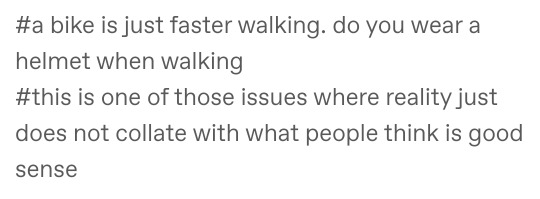
i love it when people end their dumbass points with a snappy one-liner that is technically true but in the complete opposite direction they intended
31K notes
·
View notes
Text

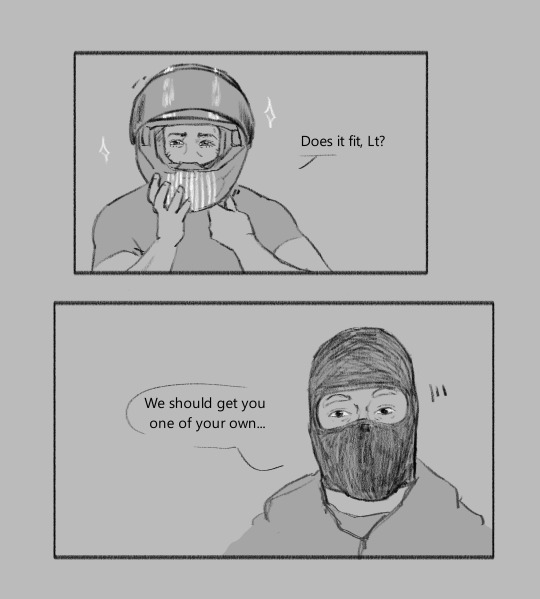
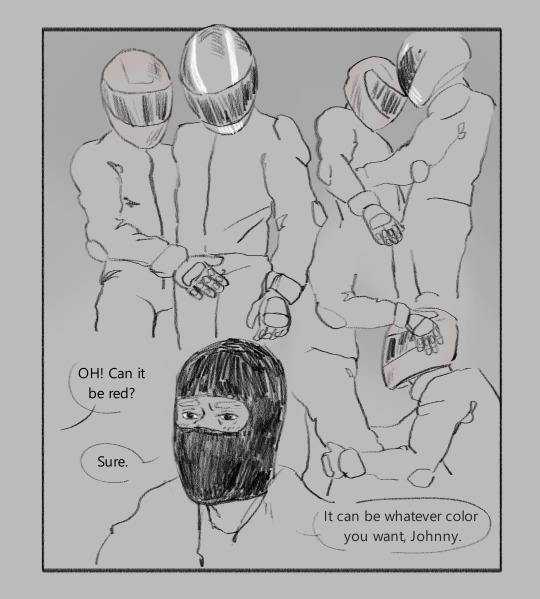
#!!! You are so right#super cute to let soap borrow his helmet to keep him safe#ghost might have a problem with bike gear tbh#comment idea#biker!ghost#simon ghost riley#ghoap#ghost x soap#dgtc tag#ghostsoap#john soap mactavish
2K notes
·
View notes
Text
0 notes
Text

Oh! A bug!
454 notes
·
View notes
Text
My dad was looking to rehome his old electric bike and I stopped by to try it out. It’s pretty tall but I think that’s what you’re supposed to get for good pedaling.
But spoiler alert. Electric bikes are just. Fun.
My chronic fatigue has meant a lot less outside time overall and a limit on fun activities that are too vigorous. But I’m genuinely like. This is so accessible and makes outdoor stuff more achievable and it was just so exciting to be riding that I fully giggled aloud.
#ramblies#they had a bike that I think will fit my beloved#so we just need helmets and bike locks. maybe a bike rack depending#but it’s really exciting#I moved my wheelchair while storing the new bikes and I was like#I could not have foreseen feeling this much better when I was in that chair#and I hope I never get that low again#but it’s exciting to move it aside for a bike
817 notes
·
View notes
Text

Bicycle helmet with LED light rechargeable
0 notes
Text

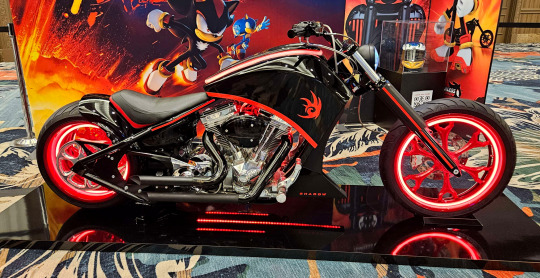

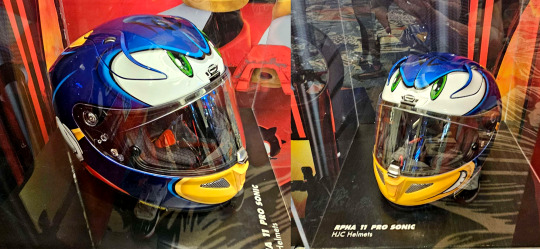
They have a Shadow the Hedgehog bike at my work place right now for a convention near our food court and you better believe I drove down there immediately on my off day to take pictures the second I found out.
#shadow the hedgehog#year of shadow#sonic#sonic the hedgehog#sth#shadow bike#shadow motorcycle#motorcycle#motorcycle helmet#it's so fucking sick in person
996 notes
·
View notes
Text
Enhancing Safety with Advanced Motorcycle Youth Helmets
Drawing on my extensive experience as a powersport bike rider, I've come to understand the critical role helmets play in ensuring safety, particularly for young riders. Advanced motorcycle youth helmets are not just smaller versions of adult helmets; they're designed with the unique needs and safety requirements of younger riders in mind. In this comprehensive blog, we'll explore how these advanced helmets enhance safety for our budding motorcycle enthusiasts.
Introduction
Introducing young riders to the world of motorcycling is an exciting but immense responsibility. One of the most crucial aspects of this initiation is equipping them with the right helmet. Advanced motorcycle youth helmets have evolved significantly, offering superior protection, comfort, and features tailored for younger riders. Understanding these advancements is key to ensuring the safety and confidence of young riders.
1. The Evolution of Youth Motorcycle Helmets
Tracing the Progress:
Technological Advancements: Discuss how youth motorcycle helmets have evolved over the years, incorporating advanced materials and technologies for better protection.
Design Innovations: Explain how modern designs focus on the specific anatomical and developmental needs of younger riders.
2. Importance of Proper Fit for Youth Riders
Ensuring the Helmet Fits Perfectly:
Measurement and Sizing: Detail the process of measuring a young rider’s head and selecting the right helmet size.
Fitment Checks: Provide tips on ensuring the helmet fits snugly but comfortably, without being too tight or too loose.
3. Safety Features in Advanced Youth Helmets
Key Components for Protection:
Material and Construction: Explore the materials used in advanced helmets, such as multi-density EPS liners and tough outer shells.
Impact Absorption Technologies: Delve into technologies like MIPS (Multi-directional Impact Protection System) and how they enhance safety.
4. Ventilation and Comfort
Maintaining Comfort During Rides:
Breathability: Explain the importance of good ventilation in youth helmets for comfort, especially during longer rides.
Adjustable Ventilation Systems: Discuss how advanced helmets come with adjustable vents for climate control.
5. Visibility and Eye Protection
Clear Vision on the Road:
Visor Technology: Cover the advancements in visor technology, such as anti-fog coating, UV protection, and scratch resistance.
Wide Field of View: Emphasize the importance of a wide field of view for young riders to enhance situational awareness.
6. Weight Considerations
Lightweight Yet Protective:
Balancing Weight and Safety: Discuss the challenge of making youth helmets lightweight for comfort while ensuring they provide adequate protection.
Material Innovations: Highlight how new materials have helped reduce helmet weight without compromising safety.
7. Integration with Communication and Tech Gadgets
Embracing Modern Technology:
Bluetooth Integration: Explore how some youth helmets come equipped with or are compatible with Bluetooth systems for communication.
Smart Helmets: Briefly touch on the emergence of smart helmets with built-in cameras, GPS, and other technology for enhanced riding experiences.
8. Stylish Designs That Appeal to Young Riders
Attracting the Young Generation:
Aesthetics: Discuss how helmet designs have become more visually appealing to young riders with vibrant colors and graphics.
Personalization: Mention options for personalization, which can make helmets more appealing to youth and encourage their use.
9. Durability and Maintenance
Long-Lasting Protection:
Building Helmets to Last: Cover the aspects of durability in youth helmets, focusing on materials and construction that withstand regular use.
Care and Maintenance: Offer tips on maintaining helmets, including cleaning and storage advice, to prolong their life.
10. Educating Young Riders on Helmet Safety
Fostering a Culture of Safety:
Awareness and Training: Highlight the importance of educating young riders about helmet safety, including how to wear them correctly and why they are essential.
Involving Them in the Choice: Discuss involving young riders in the helmet selection process to help them understand the importance of their safety gear.
Conclusion
Advanced motorcycle youth helmets are pivotal in safeguarding our young riders. These helmets, equipped with the latest safety features, technology, and designs, not only protect but also instill a sense of responsibility and style in young riders. As experienced riders, our role extends beyond just providing these helmets; it involves educating and nurturing a safety-first mindset among the younger generation. By doing so, we ensure that they enjoy the thrill of riding while being well-protected and informed.
0 notes